|
|
| |
|
|
| |
|
|
|
|
| |
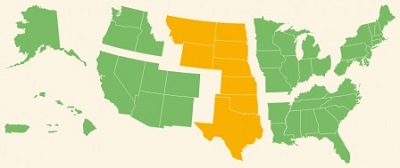 Climate
Impacts in the Great Plains Climate
Impacts in the Great Plains
Overview
The Great Plains stretch from Canada to Mexico across the
midsection of the country and consist of relatively flat
plains that span from mountain elevations to sea level. The
Plains are made up of a broad range of ecosystems, including
forests, rangelands, marshes, and desert. This coincides
with a highly diverse climate and large geographic variation
in temperature and precipitation across the region. |
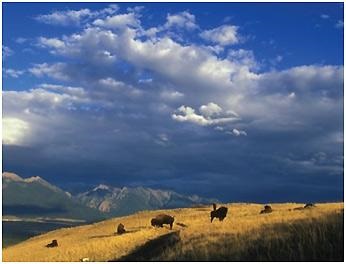 Because
the Great Plains extend the entire north-south length of the
United States, the region experiences a wide range of
seasonal and average annual temperatures. In the mountains
of Montana and Wyoming, average temperatures are less than
40°F, while in southern Texas, it is 70°F. Warming
temperatures are being felt across the Great Plains. North
Dakota's average temperature has increased faster than any
other state in the contiguous United States, and the number
of days with temperatures over 100°F is projected to double
in the Northern Plains by 2050. The Southern Plains are
projected to experience more extreme heat, with four times
the number of days over 100°F than is currently experienced
in the area. These temperature changes are expected to occur
largely in the summer, but winter temperatures will also
increase in the Northern Plains. Higher temperatures lead to
greater evaporation and surface water losses, more heat
stress, and increased energy demand for cooling. Because
the Great Plains extend the entire north-south length of the
United States, the region experiences a wide range of
seasonal and average annual temperatures. In the mountains
of Montana and Wyoming, average temperatures are less than
40°F, while in southern Texas, it is 70°F. Warming
temperatures are being felt across the Great Plains. North
Dakota's average temperature has increased faster than any
other state in the contiguous United States, and the number
of days with temperatures over 100°F is projected to double
in the Northern Plains by 2050. The Southern Plains are
projected to experience more extreme heat, with four times
the number of days over 100°F than is currently experienced
in the area. These temperature changes are expected to occur
largely in the summer, but winter temperatures will also
increase in the Northern Plains. Higher temperatures lead to
greater evaporation and surface water losses, more heat
stress, and increased energy demand for cooling.
Picture - The Great
Plains is home to the Rocky Mountains, prairie and grassland
ecosystems, and the American Bison. Credit: USGCRP (2014) |
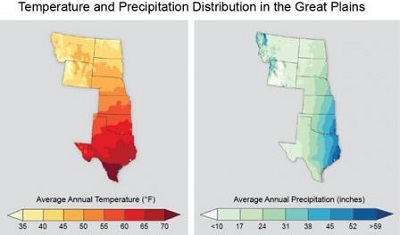 The
Great Plains has a distinct east-west gradient in average
precipitation, with eastern Texas and Oklahoma experiencing
more than 50 inches per year, while some of Montana,
Wyoming, and western Texas receive less than 15 inches per
year. Climate change projections indicate that future
precipitation patterns will vary across the region and at
local scales. In northern states, the amount of winter and
spring precipitation and the number of days with heavy
downpours and snowfall are projected to increase. In the
central Great Plains, less summer rainfall is projected and
could lead to drier summers in some areas. Southern states,
including Texas and Oklahoma, are also projected to
experience longer periods without rainfall. The
Great Plains has a distinct east-west gradient in average
precipitation, with eastern Texas and Oklahoma experiencing
more than 50 inches per year, while some of Montana,
Wyoming, and western Texas receive less than 15 inches per
year. Climate change projections indicate that future
precipitation patterns will vary across the region and at
local scales. In northern states, the amount of winter and
spring precipitation and the number of days with heavy
downpours and snowfall are projected to increase. In the
central Great Plains, less summer rainfall is projected and
could lead to drier summers in some areas. Southern states,
including Texas and Oklahoma, are also projected to
experience longer periods without rainfall.
Picture - The Great
Plains has a distinct north-south gradient in average
temperature patterns (left), with a hotter south and colder
north. For precipitation (right), the regional gradient runs
east-west, with a wetter east and a much drier west.
Averages shown here are for the period 1981-2010. Source:
USGCRP (2014)
Impacts on Vulnerable Communities
The Great Plains is home to a diverse cultural,
geographical, and economic population that will experience
the impacts of climate change in different ways. Climate
change related impacts, including heat waves and extreme
weather events, have disproportionate effects on vulnerable
groups, including young, elderly, ill, and low income
populations. In the Great Plains, remotely located
populations, including 70 recognized indigenous tribes and a
growing proportion of elderly residents, face greater
challenges in responding to climate change because of a lack
of development, public health resources, and access to other
public services and communication systems. Language barriers
for indigenous groups can also impact the ability to respond
to climate extremes.
Climate change is also affecting tribal community traditions
and culture. Earlier onset of spring is changing the timing
of rituals, and regions have faced the decline and
disappearance of some culturally important plants and
animals. For centuries, tribal groups have adapted to
changes in the climate, but currently face heightened
constraints of physical and political boundaries, poverty,
and a lack of resources. Despite these challenges, some
groups are actively working to establish long-term
sustainability plans that will foster adaptation and
protection of important cultural resources. |
|
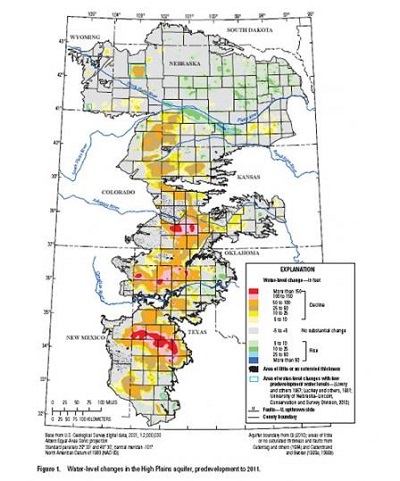 Impacts
on Water Resources Impacts
on Water Resources
As patterns of temperature and precipitation change, the
Great Plains region is expected to face increased
competition for water supplies for use by homes, business,
agriculture, and energy production. Water in this region
comes largely from the High Plains Aquifer system, made up
largely of the Ogallala aquifer. The High Plains Aquifer
system is one of the largest freshwater aquifers in the
world and underlies approximately 111 million acres in parts
of Colorado, Kansas, Nebraska, New Mexico, Oklahoma, South
Dakota, Texas, and Wyoming. Nearly 30% of all irrigated
lands in the United States reside above this aquifer, making
it one of the primary agricultural regions in the nation.
The High Plains Aquifer also provides drinking water for
more than 80% of the residents living over the aquifer and
is key to the region's energy production.
Picture - Water-level
changes in the High Plains Aquifer between the start of
irrigation (around 1950) and 2011. Declines in water level
have been observed across much of the southern portion of
this aquifer. Source: USGS (2013) USGS has also provided a
video of aquifer declines.
Long-term declines in the water level within the High Plains
Aquifer have resulted from greater water discharge than
recharge. Discharge (or withdrawal) occurs largely by
irrigation, which has resulted in an average water level
decline of 14.2 feet since irrigation began around 1950.
This translates to an 80 trillion gallon reduction in water
storage within the aquifer. Recharge (or replenishing) comes
primarily from precipitation. In the northern portion of the
Great Plains, rain can recharge the aquifer quickly.
However, with climate change, precipitation in the winter
and spring is projected to increasingly fall in the form of
very heavy precipitation events, which can increase flooding
and runoff that reduce water quality and cause soil erosion.
In the southern portion of the region, little recharge
occurs, so declines in the aquifer's water level are much
greater (see figure of High Plains Aquifer). Climate change
will worsen this situation by causing drier conditions and
increasing the need for irrigation.
For more information on climate change impacts on water,
please visit the Water Resources Impacts page. |
|
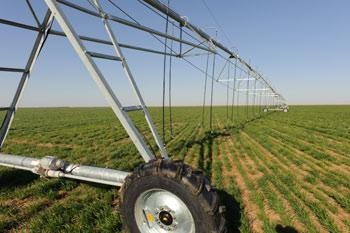 Impacts
on Agriculture Impacts
on Agriculture
Agriculture in the Great Plains utilizes more than 80% of
the land area. In 2012, agriculture in the region was
estimated to have a total market value of $92 million, made
up largely of crop (43%) and livestock (46%) production.
Projected climate change will have many impacts on this
sector. Some impacts may provide short-term benefits, but
negative effects are also likely in this time frame. In the
long-term, climate impacts will have increasingly
detrimental effects that increase variability in crop and
agricultural production. Climate change may also cause a
northward shift in lands used for agricultural production as
temperature and water stresses rise, especially in the
southern portion of the region.
Picture - Center pivot
sprinkler irrigation system located on a winter wheat cover
crop in Morton, Texas. Credit: USDA
Crops
In the Northern Plains, crop yields benefit from increased
precipitation in winter and spring. However, if the fields
become too wet, planting may be delayed and affect yields.
The projected heavier rainfall will also increase erosion
and nutrient runoff, which could have detrimental impacts on
crops and agricultural soil quality. Warmer temperatures
lengthen the growing season, which could increase plant
growth or allow for a second planting. Higher levels of
carbon dioxide may also increase plant growth. However,
summer precipitation is not projected to rise, which
increases vulnerability to drought conditions, while higher
summer temperatures are likely to reduce plant productivity.
In the Central and Southern Plains, the higher temperatures
and decreased precipitation will increase irrigation
demands. If irrigation is reduced to conserve water and
farmers transition to dryland agriculture, crop yields could
be reduced by a factor of two.
The Great Plains is already experiencing warmer winters, and
further temperature increases are projected for this season.
These conditions can increase the survival of some pests and
invasive weeds. Additionally, the dormancy period for winter
crops is shortening, increasing the potential for damage by
spring freezes and reducing yields of some important
livestock feed crops, such as winter wheat. As climate
impacts worsen in the future, agricultural practices will
face increased risks that require new considerations and
management strategies. |
|
|
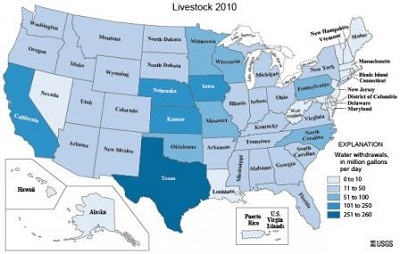 Livestock Livestock
Livestock production is a major component of the economy in
the Great Plains. By value, Texas produces the most cattle
in the United States. Warmer temperatures and extreme heat
stress animals and cause declines in meat, milk, and egg
production.[6] Diseases may also increase as temperature and
moisture conditions become more favorable for disease spread
and range expansion. Additional expenses may also be
incurred as the need to cool animal buildings increases.
Picture - Daily water
withdrawals associated with livestock operations in 2010.
Source: USGS (2014)
Drought and increasing demand for available fresh water is
already affecting the livestock industry. Animal operations
require large quantities of water for drinking water,
feedlot operations, dairy farms, and other on-farm needs.
Some of the largest water withdrawals in the country occur
in the Great Plains, with Texas having the highest water
usage for livestock in the country. Continued livestock
production and associated water usage in this region will
exacerbate water shortages as climate change impacts
continue.
For more information on climate change impacts on
agriculture, please visit the Agriculture and Food Supply
page. |
|
|
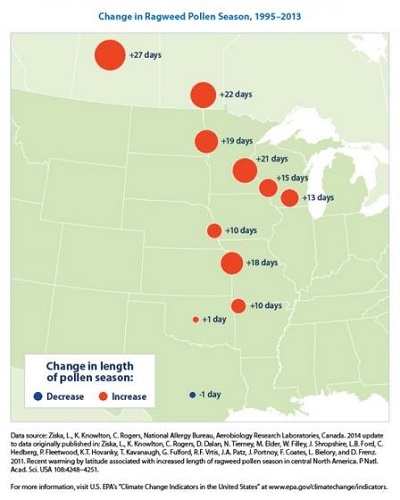 Impacts
on Ecosystems Impacts
on Ecosystems
Climate and land use are changing simultaneously in the
Great Plains and altering many ecosystems. Land development
for energy production and urban sprawl are increasing
habitat fragmentation. This lessens the ability of plants
and animals to adapt by moving to new areas in response to
warmer temperatures or changes in water availability.
Climate change is also increasing pest outbreaks, spreading
invasive species, accelerating wildfire activity, and
changing plant flowering times. An increase in frost-free
days in the Great Plains have lengthened the pollen season
for the common allergen ragweed, increasing the likelihood
of allergic reactions and associated health impacts.
Picture - The ragweed
pollen season has increased across most of the Great Plains
and Midwest. This figure shows the change in the length of
the ragweed pollen season between 1995 and 2013 at 11
locations. Red circles indicate a longer pollen season and
the blue circle represents a shorter season. Larger circles
indicate larger changes. Source: US EPA (2015) |
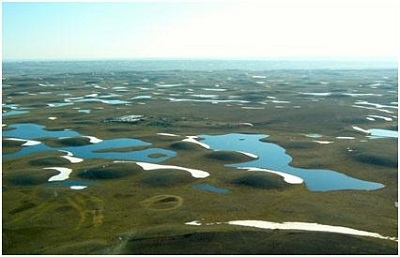 Climate
change is affecting critical game species in the Great
Plains, including a number of birds (including ducks, geese,
and quail), mammals (including moose and deer), and fish
(including bass).[9] Many of these animals rely on the
availability of shallow lakes that periodically dry out.
These areas, known as Prairie Potholes (in the north) or
playa lakes (in the south), provide habitat for many species
to mate and nurture offspring. The lakes also help recharge
the High Plains Aquifer. Agricultural practices have changed
more than 70% of the large seasonal lakes in the southern
Great Plains. As temperatures continue to rise, the bird and
fish populations that rely on these areas are increasingly
impacted. Climate
change is affecting critical game species in the Great
Plains, including a number of birds (including ducks, geese,
and quail), mammals (including moose and deer), and fish
(including bass).[9] Many of these animals rely on the
availability of shallow lakes that periodically dry out.
These areas, known as Prairie Potholes (in the north) or
playa lakes (in the south), provide habitat for many species
to mate and nurture offspring. The lakes also help recharge
the High Plains Aquifer. Agricultural practices have changed
more than 70% of the large seasonal lakes in the southern
Great Plains. As temperatures continue to rise, the bird and
fish populations that rely on these areas are increasingly
impacted.
Picture - Image of the
wetland ecosystem known as prairie potholes. Credit: USGS
For more information on climate change impacts on
ecosystems, please visit the Ecosystems Impacts page. |
|
|
EPA Page |
|
This is the
EPA page for this topic. To see if the Trump
administration has changed the EPA page, simply click the
link and compare the information with this page. If you
notice changes were made to the EPA page, please post a
comment. Thanks. |
|
|
Key Points
Warmer winters are altering crop growth cycles and will
require new agriculture and management practices as climate
change impacts increase.
Projected increases in temperature and drought frequency
will further stress the High Plains Aquifer, the primary
water supply of the Great Plains.
Changes in water availability are likely to present
challenges to agricultural irrigation and threaten key
wetland habitats.
Older residents in rural areas and people living on Native
American reservations are especially vulnerable to the
impacts of climate change. |
|
|
|
|
|
|
|
|
|
|
|
|
Additional Climate Change Information |
Climate Change and Carbon Dioxide
(Beginner - Listening,
reading)
A video lesson to
help with your understanding of climate change
and carbon dioxide.
The English is
spoken at 75% of normal speed.
Great English listening and reading practice. |
Carbon Dioxide and Climate Change
(Beginner - Listening,
reading)
A video lesson to
help with your understanding of carbon dioxide
and climate change.
The English is
spoken at 75% of normal speed.
Great English listening and reading practice. |
Environmental Group Warns Earth's Health at Risk
(Beginner - Listening,
reading)
A video lesson to
help with your understanding of climate change.
The English is
spoken at 75% of normal speed.
Great English listening and reading practice.
A report by the World Wildlife Fund looked at thousands of animal populations
and found they have dropped significantly in 40 years. |
Sea Levels Rising at Fastest Rate in 3,000 years
(Beginner - Listening,
reading)
A video lesson to
help with your understanding of climate change.
The English is
spoken at 75% of normal speed.
Great English listening and reading practice.
A group of scientists say sea levels are rising at record rates. Another group
found that January temperatures in the Arctic reached a record high. |
Capturing CO2 Gas Is Not Easy
(Beginner - Listening,
reading)
A video lesson to
help with your understanding of climate change.
The English is
spoken at 75% of normal speed.
Great English listening and reading practice.
Most scientists agree that carbon-dioxide gas is partly to blame for climate
change: rising global temperatures. But capturing the CO2 gas released by power
stations is costly and difficult. |
Growth, Climate Change Threaten African Plants and
Animals
(Beginner - Listening,
reading)
A video lesson to
help with your understanding of climate change.
The English is
spoken at 75% of normal speed.
Great English listening and reading practice.
Researchers believe Africa may lose as much as 30 percent of its animal and
plant species by the end of this century. |
|
|
|
|
Search Fun Easy English |
|
|
|
|
|
|
|
|
|
|
|
|
|
|
|
About
Contact
Copyright
Resources
Site Map |